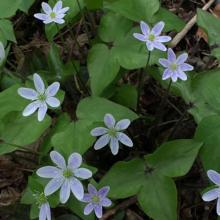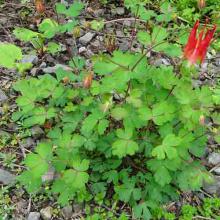Hepatica acutiloba
Common name:
Sharplobe hepatica
Genus:
Hepatica
Family:
Ranunculaceae
Order:
Ranunculales
Aquilegia canadensis
Common name:
Red columbine
Genus:
Aquilegia
Family:
Ranunculaceae
Order:
Ranunculales
Hepatica acutiloba
Common name:
Sharplobe hepatica
Genus:
Hepatica
Family:
Ranunculaceae
Order:
Ranunculales
Aquilegia canadensis
Common name:
Red columbine
Genus:
Aquilegia
Family:
Ranunculaceae
Order:
Ranunculales
Hepatica acutiloba
Common name:
Sharplobe hepatica
Genus:
Hepatica
Family:
Ranunculaceae
Order:
Ranunculales
Aquilegia canadensis
Common name:
Red columbine
Genus:
Aquilegia
Family:
Ranunculaceae
Order:
Ranunculales
Family (Plantae): Ranunculaceae
Ranunculaceae (buttercup or crowfoot family; Latin rānunculus "little frog", from rāna "frog") is a family of over 2,000 known species of flowering plants in 43 genera, distributed worldwide.
The largest genera are Ranunculus (600 species), Delphinium (365), Thalictrum (330), Clematis (325), and Aconitum (300).
Description
Ranunculaceae are mostly herbaceous annuals or perennials, but some woody climbers (such as Clematis) or shrubs (e.g. Xanthorhiza).
Most members of the family have bisexual flowers which can be showy or inconspicuous. Flowers are solitary, but are also found aggregated in cymes, panicles, or spikes. The flowers are usually radially symmetrical but are also found to be bilaterally symmetrical in the genera Aconitum and Delphinium. The sepals, petals, stamens and carpels are all generally free (not fused), the outer flower segments typically number four or five. The outer stamens may be modified to produce only nectar, as in Aquilegia, Helleborus and Delphinium.
In some genera, such as Thalictrum the sepals are colorful and appear petal-like (petaloid) and the petals can be inconspicuous or absent. The stems are unarmed. The leaves are variable. Most species have both basal and cauline (stem) leaves, which are usually compound or lobed but can be simple. They are typically alternate, or occasionally opposite or even whorled. Many species, especially the perennials form rhizomes that develop new roots each year. Ficaria verna can reproduce vegetatively by means of root tubers produced in the leaf axils. Some members of the genus Thalictrum utilize anemophily while others utilize entomophily. Flowers of the entomophilous genus Papaver, also of the Ranunculales order, produce only pollen. Until recently, it was believed that the species of the genus Anemone also lack nectar.
The fruits are most commonly free, unfused achenes (e.g. Ranunculus, Clematis) or follicles (e.g. Helleborus, Eranthis, Nigella), but a berry in Actaea.
Phytochemistry
Ranunculaceae contain protoanemonin, which is toxic to humans and animals. Contact with plant sap may cause inflammation and blistering of the skin, while ingestion can cause irritation of the mouth, vomiting, and diarrhea. Other poisonous or toxic compounds, alkaloids and glycosides, are also common.
Taxonomy
Takhtajan (1997) included the Ranunculaceae as the only family in the Ranunculales which he placed in a subclass, the Ranunculidae, instead of a superorder. Previously, Thorn (1992) placed the Ranunculaceae in the Berberidales, an order within the Superorder Magnolianae. Earlier Cronquist in 1981 included the Ranunculaceae along with seven other families in the Rancunculales which was included in the Magnoliidae, which he regarded as a subclass. David, (2010) placed the Ranuculaceae, together with the Eupteleaceae, Lardizabalaceae, Menispermaceae, Berberidaceae, and Papaveraceae in the Ranunculales, the only order in the superorder Ranunculanae. This follows the work of the Angiosperm Phylogeny Group.
The family Ranunculaceae sensu stricto (APG) is one of seven families included in the order Ranunculales within the eudicots according to the Angiosperm Phylogeny Group classification. The family is monophyletic with Glaucidium as sister to the remaining genera. This phylogeny is illustrated in the APG Poster.
Reference: Wikipedia


